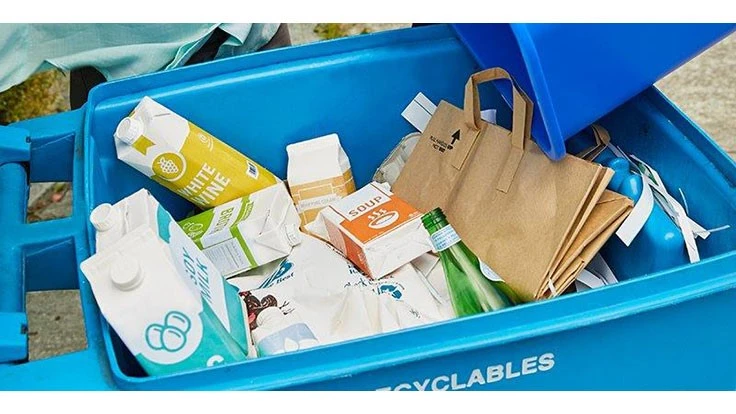
As communities across the United States struggle to find new end markets for recyclables affected by China’s import restrictions, one commodity is bucking the trend: food and beverage cartons.
Postconsumer cartons continue to be in demand and have good end markets, even at a time when markets for other commodities are decreasing. China has never been a market for bales of grade No. 52 cartons from the U.S., so communities can and should continue to recycle cartons.
Cartons are made primarily of high-quality fiber that should not end up in landfills. One common misconception about cartons is that they can’t be recycled or are hard to recycle because they have multiple layers. Gable-top cartons, the kind that package milk, creamer, egg whites and other refrigerated products, are made mostly of paper with thin layers of polyethylene to hold in the liquid. Aseptic, or shelf-stable, cartons that package juice drinks, soups, wine and other nonrefrigerated products also contain a layer of aluminum to block out light and oxygen.
.gif)
Cartons are recyclable, and collected grade No. 52 cartons have several domestic and international end markets. At a paper mill, the layers in cartons are broken down and separated. The pulp is used to make new paper products, and the polyethylene and aluminum can be used to generate energy or are sold to manufacturers that use them for lumber-board-like materials. A second, growing end-market option is manufacturers similar to Continuus Materials in Des Moines, Iowa, that use the entire carton to make eco-friendly building and construction products through a process that uses no water or chemicals. The polyethylene and aluminum components (including the caps and straws) act as a binding agent when combined with the fiber, and are recycled into roof cover board, wallboard and other building materials.
To get the highest value, the Carton Council recommends material recovery facilities (MRFs) sort cartons into grade No. 52. If not sorted by themselves, cartons are generally baled with mixed paper, which isn’t optimal for achieving the highest quality and value.
For recycling coordinators and other recycling educators, this means cities and counties can continue to recycle cartons with confidence or start including cartons in their recycling programs. Now more than ever, communities must educate residents that recycling the right materials is important and critical to keeping recyclables out of landfills while eliminating contamination.
Research proves this point. A study released by the Carton Council of North America last year found that nearly three-quarters (74 percent) of people believe recycling is important and should be a priority. Americans don’t just think recycling should be a priority. They are acting on it. The survey also found that 61 percent of respondents said they always recycle their food and beverage cartons, up from 50 percent in the previous survey conducted in 2015.
Recent negative and confusing information about recycling provides a good opportunity for communities to educate residents about items that should and shouldn’t be recycled. When part of a community’s recycling program, food and beverage cartons should be listed on the community website and in all educational materials as recyclable. Residents just need to empty them and toss them into their recycling bins. No need to crush them or remove the caps.
Despite challenges facing the recycling industry, the public wants and believes in recycling. The overwhelming majority of people surveyed by the Carton Council (94 percent) said they supported recycling, and nearly all cited environmental or altruistic reasons for recycling. Additionally, they have high expectations for brands, expecting them to actively help boost the recycling of packages they use.
As communities look for ways to improve the viability of recycling, some MRFs are turning to better technology for sorting cartons. The Carton Council is proud to have pioneered the introduction of robots in recycling in collaboration with other forward-thinking stakeholders. In 2017, we partnered with Amp Robotics, Denver, to pilot the first recycling robots at Alpine Waste and Recycling in Denver and Dem-Con Cos. in Minneapolis.
The robots are programmed to recognize carton designs, logos and shapes and learn as they go using artificial intelligence. They can pick up to 80 cartons per minute, require less investment and take up less space than other types of automated sorting technologies. The knowledge learned over time can be transferred to other systems across the country, further increasing the effectiveness of carton recycling.
Today, robots are being installed to sort cartons as well as other materials across the country. They can provide an efficient way for facilities to sort cartons into grade No. 52.
Advancements in technology at MRFs and the development of new and expanded end markets for cartons allow communities to continue and strengthen recycling programs for cartons. Now is not the time to scale back on the progress made in carton recycling. Instead, it is the time to reiterate the recyclability of cartons and take steps to ensure postconsumer cartons are captured and turned into new products.
Derric Brown is vice president of sustainability for the Carton Council of North America and director of sustainability for Evergreen Packaging, Memphis, Tennessee.
Latest from Waste Today
- Closed Loop Partners acquires organic waste management company
- LanzaTech revenue declines as it refocuses on carbon capture
- Bandit ties giveaway to 100,000th machine
- Fayetteville, Arkansas, extends curbside composting pilot
- Synagro releases 2024 sustainability report
- American AF Dumpsters acquires Live Oak Dumpsters
- Landfill Insights | Safe spacing for heavy equipment at the landfill
- Viridor reportedly up for sale





